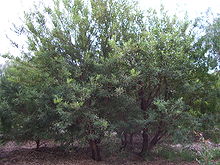
Hakea salicifolia commonly known as the willow-leaved hakea, is species of flowering plant that is endemic to eastern Australia. It is an adaptable, fast growing small tree or shrub with attractive foliage and cream white flowers.

Kennedia is a genus of thirteen species of flowering plants in the pea family Fabaceae and is endemic to Australia. Plants in this genus are prostrate or climbing perennials with trifoliate leaves and large, showy, pea-like flowers. There are species in all Australian states.

Ozothamnus diosmifolius is an erect, woody shrub in the family Asteraceae and is endemic to eastern Australia. Common names for this species include rice flower, white dogwood, pill flower and sago bush. It has dense heads of small white "flowers" and is often used in floral arrangements.
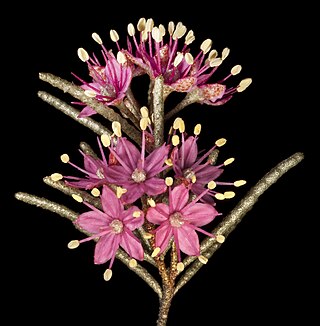
Phebalium is a genus of thirty species of shrubs or small trees in the family Rutaceae and is endemic to Australia. The leaves are arranged alternately, simple and often warty, the flowers arranged singly or in umbels on the ends of branchlets or in leaf axils, usually with five sepals, five petals and ten stamens. There are about thirty species and they are found in all Australian states but not in the Northern Territory.

Hibiscus heterophyllus, commonly known as native rosella or toilet paper bush, is a flowering plant in the family Malvaceae. It a shrub or small tree with white, pale pink or yellow flowers with a dark red centre and grows in New South Wales and Queensland.

Allocasuarina distyla, commonly known as scrub she-oak, is a species of flowering plant in the family Casuarinaceae and is endemic to south-eastern New South Wales. It is a dioecious shrub that has branchlets up to 350 mm (14 in) long, the leaves reduced to scales in whorls of six to eight, the fruiting cones 13–35 mm (0.51–1.38 in) long containing winged seeds (samaras) 4.0–8.0 mm (0.16–0.31 in) long.

Aotus ericoides, also known as common aotus or golden pea, is a shrub in the family Fabaceae. It flowers in leaf axils in spring and has yellow pea flowers with splotches of red. It is endemic to eastern Australia.

Calomeria is a plant genus in the family Asteraceae.

Kennedia coccinea, commonly known as coral vine, is a species of flowering plant in the family Fabaceae and is endemic to the south-west of Western Australia. It is a twining, climbing or prostrate shrub with trifoliate leaves and orange-pink, red and pink, pea-like flowers.

Kennedia rubicunda, commonly known as the dusky coral pea, is a species of flowering plant in the family Fabaceae and is endemic to eastern continental Australia. It is a twining or prostrate herb with trifoliate leaves and dark red or purple flowers.

Felicia filifolia is a Southern African member of the family Asteraceae. It is a hardy, sprawling shrub growing to about 1 metre tall. Leaves are narrow and clustered along the twigs. When blooming it is densely covered in flowerheads with ray florets that are pink-mauve to white and disc florets that are yellow. In the wild, flowers can be found August to December.
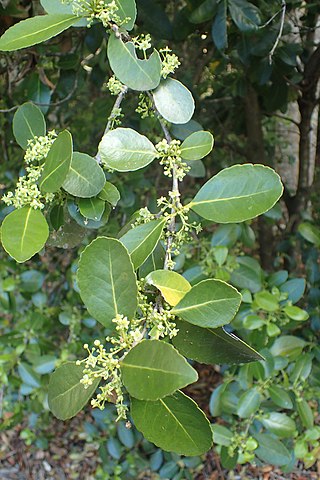
Elaeodendron australe, commonly known as red olive-berry, red-fruited olive plum, or blush boxwood, is a species of flowering plant in the family Celastraceae and is endemic to eastern Australia. It is a shrub or small tree with egg-shaped to oblong leaves with a wavy margin, yellowish green male and female flowers on separate plants and fleshy orange-red fruit.

Phebalium squamulosum , commonly known as scaly phebalium or forest phebalium, is a species of shrub or slender tree that is endemic to eastern Australia. It has smooth branches covered with rust-coloured scales, linear to elliptical or egg-shaped leaves with the narrower end towards the base, and pale to bright yellow flowers in umbels with rust-coloured or silvery scales on the back.
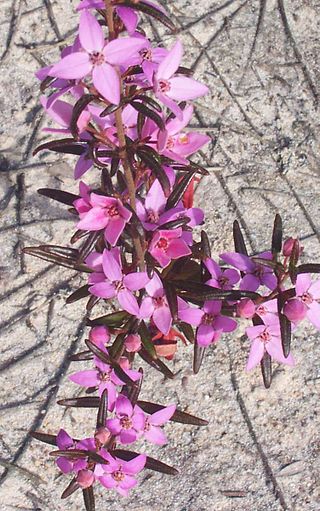
Boronia ledifolia, commonly known as the Sydney boronia, showy boronia or ledum boronia, is a plant in the citrus family Rutaceae and is endemic to south-eastern Australia. It is a shrub with simple or pinnate leaves which have a strong odour when crushed, and pale to bright pink flowers. Although difficult to propagate, this boronia is a popular garden plant.
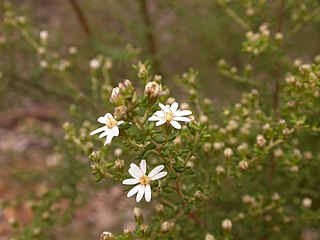
Olearia microphylla, commonly known as snow bush, small-leaved daisy-bush or twiggy daisy-bush, is a species of flowering plant in the family Asteraceae and is endemic to eastern Australia. It is a shrub with spatula-shaped leaves with the edges rolled under, and white and yellow, daisy-like inflorescences.

Bossiaea heterophylla, commonly known as variable bossiaea, is a species of flowering plant in the family Fabaceae and is endemic to south-eastern Australia. It is a variable shrub with flattened stems, egg-shaped to linear leaves, and yellow and dark red flowers.

Acacia pubescens, also known as the downy wattle, is a species of wattle found in the Sydney Basin in eastern New South Wales. The downy wattle is classified as vulnerable; much of its habitat has vanished with the growth of the city of Sydney. As with all wattles, it has compound (pinnate) leaf stems.

Acacia linifolia, known colloquially as white wattle, or flax wattle, is a species of Acacia native to eastern Australia.

Bossiaea obcordata, commonly known as spiny bossiaea, is a species of flowering plant in the family Fabaceae and is endemic to south-eastern continental Australia. It is an erect, rigid shrub with spiny branches, heart-shaped to egg-shaped with the narrower end towards the base, and yellow and purplish-brown flowers.

Pomaderris discolor is a species of flowering plant in the family Rhamnaceae and is endemic to south-eastern continental Australia. It is a shrub with woolly-hairy stems, elliptic leaves, and clusters of pale yellowish flowers.

